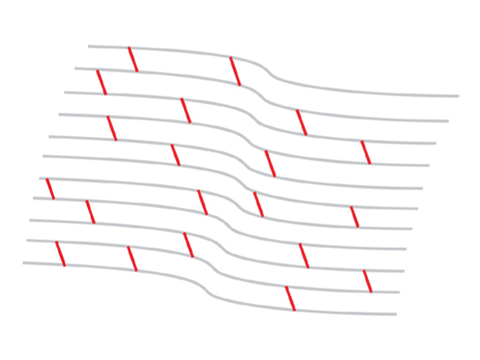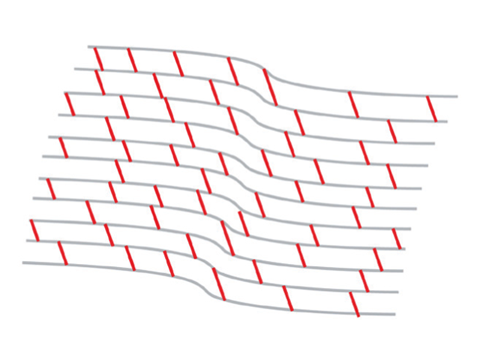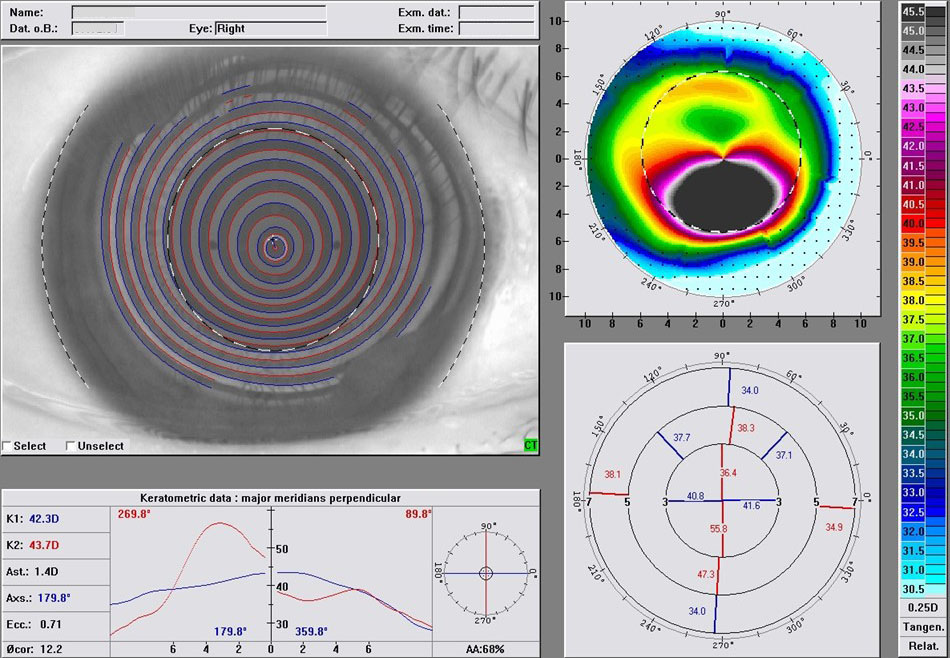The cornea is mostly made of collagen fibres which are arranged in bundles. Its strength and rigidity are partly determined by how strongly these fibres are linked together.

Less crosslinking between
collagen fibres of the cornea

More crosslinking between
collagen fibres of the cornea
In corneal ectasia, the cornea is weakened either:
- Pathologically (e.g. keratoconus, pellucid marginal degeneration, keratoglobus)
- Iatrogenically (e.g. post-LASIK, ReLEx® SMILE, PRK, corneal ectasia)
What is Keratoconus?
Keratoconus is a very uncommon eye disease and is caused by an irregularly thinned cornea. The keratoconic cornea is distorted and bulges forward. This condition can be picked up by performing a corneal topography.
Symptoms of Keratoconus
- Poor spectacle vision, frequently distorted by high astigmatism
- Double vision and smearing of vision
- A need to change the spectacles or contact lenses frequently
- Not being able to wear contact lenses as they no longer fit and feel uncomfortable
- Increased sensitivity to light and glare
What the Examination Reveals
- Refraction: High amounts of astigmatism present
- Corneal topography: Inferior steepening and corneal distortion, abnormally high amounts of astigmatism and coma
- Optical coherence tomography (cornea): Usually, the inferior half of the cornea is extremely thin

How is Keratoconus Treated?
In mild cases, keratoconus can be managed by:
- Changing glasses or contact lenses
- Fitting customised contact lenses such as rigid gas permeable (RGP) or hybrid lenses
If vision can no longer be corrected by spectacles or contact lenses, you may be advised to undergo surgery such as:
- Corneal collagen crosslinking (CXL) with laser transepithelial phototherapeutic keratectomy (TransPRK)
- Corneal transplant
What is Corneal Collagen Crosslinking (CXL)?
Corneal collagen crosslinking (CXL) is a superficial treatment to strengthen the weakened cornea.
How is it done?
The procedure takes approximately 30 minutes.
- Topical anaesthesia is administered.
- The epithelium (superficial layer of cornea) is removed with a laser.
- The remaining cornea will be soaked with topical Riboflavin (Vitamin B2) eyedrops.
- The vitamin B2 treated cornea is exposed to ultraviolet light which crosslinks and bonds adjacent corneal collagen fibres to strengthen the weakened cornea.
- A special bandage contact lens will be placed on the eye for 3 to 4 days to promote healing of the epithelium as well as to provide comfort during the post-operative period.
During the first few days after the surgery, the eye will be slightly sore and teary. The patient will experience minimal haziness of vision (most patients do not notice the haziness) for a few months after CXL. By 6 months, the hazy vision is usually gone.
What is the effect of CXL on keratoconic and post-LASIK ectasia patients?
- Stabilise the corneas. The stabilisation occurs over a period of 10 to 20 years.
- Iatrogenically
- Improve corneal topography, astigmatism and visual acuity
New developments in the treatment of ectasia
As an adjunct to corneal collagen crosslinking, the cornea can be reshaped with a topography-guided or corneal wavefront-guided laser. This improves the shape of the cornea before strengthening it. The visual results of this kind of therapy are generally superior to corneal collagen crosslinking done alone.
More details can be discussed when you consult with Dr Jerry Tan.
Contact Us for an Appointment today!









Safety, Quality, Care and Concern